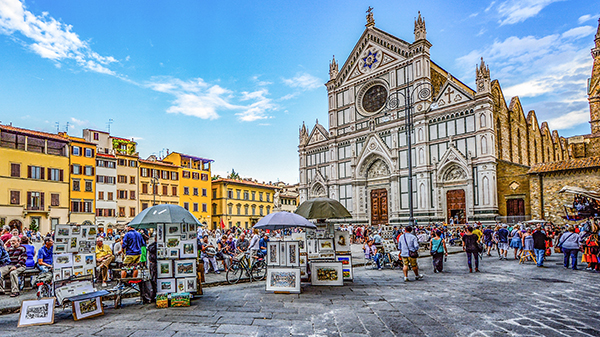As the birthplace of the Italian Rennaissance, Florence, has long enjoyed a reputation for being among the foremost cultural and economic cities in Europe for centuries, one that continues to the present. Today, though modernity has permeated its borders, there are constant reminders of its rich history, be it the narrow cobblestone paths that meander between the buildings or the iconic monuments that punctuate its acreage.
Set amidst rolling hills and verdant fields along the picturesque Arno River, the city of Firenze – to give it its Italian name – was first settled by intrepid Roman legions during the first century BC as a military colony. Across the intervening millennia, it was, in turns, the seat of the Dukes of Tuscany, the Italian capital (1865-70), a republic, and the headquarters of the iconic Medici banking family who ruled the city on and off for almost three centuries.
“Florence has birthed such cultural luminaries as Da Vinci, Michelangelo, Dante and Galileo”
Perhaps even more famous than these ruling factions are the artistic and creative visionaries that Florence birthed, including the likes of luminaries such as Leonardo Da Vinci, Michelangelo, Dante, Galileo and Machiavelli. These were the masters who contributed to the birth of the Italian Renaissance, a period of cultural revival between the 14th and 17th centuries that saw interest in everything from science and sculpture to philosophy and exploration experience a resurgence.
Thanks to the enduring physical legacy left behind by this movement, in 1982, Florence was officially designated a UNESCO World Heritage Site. Today, the Tuscan capital boasts a population of just over 380,000 souls, with 5.37 million tourist arrivals recorded in 2018 alone. Most of them visiting to witness the city’s historic and artistic significance such as the bygone eras, and none are more iconic than the Duomo di Firenze, or Florence Cathedral, the large Gothic religious monument famed for its towering dome.
The Duomo was originally designed in 1296, but it wasn’t until 1436 – over a century later – that the cathedral was finally completed. After standing incomplete for decades, in 1418, the city council announced a design competition for its completion, a commission won by Filippo Brunelleschi thanks to his revolutionary ‘octagonal’ design. Now, it stands 114m high and 45m wide, and is one of Italy’s largest basilicas. The biggest artwork within the cathedral is renowned artist Giorgio Vasari’s frescoes of the Last Judgment (1572-9). In truth, though, they were designed by Vasari but painted mostly by his less-talented student Frederico Zuccari by 1579. Several other features within and around the magnificent cathedral defines true masterpieces of Renaissance art.
Art lovers, meanwhile, can’t miss out on a visit to the Uffizi Palace and Gallery and Gelleria dell’Accademia. The first is located right off Piazza dell Signoria, this world-renowned museum is one of Italy’s most prominent repositories of historical artefacts, including such legendary creations as The Baptism of Christ by Da Vinci, the Adoration of the Magi by Botticelli and the Sacrifice of Isaac by Caravaggio.
The Galleria dell’Accademia was set in the shadows of the Florence Cathedral. Despite its innocuous exteriors, this seemingly-humble building is actually home to some masterpieces of Renaissance art. Key among these, of course, is the original David sculpture, the iconic statue crafted by Leonardo Da Vinci and now known across the globe.
For a welcome outdoor reprieve, one could do far worse than meander Arno River. Here you’ll find yet another historic relic – the Ponte Vecchio, an ancient bridge said to date back to 996 AD connects the two banks. Today, its interiors are awash with art dealers, jewellery shops and souvenir vendors, but if you stop midway through, you will be rewarded with direct views down the Arno.
If you’re famished from your Florentine escapades, the local culinary scene will not disappoint. As the Tuscan capital, its streets are awash with eateries serving iconic regional dishes. A must-have is Bistecca alla Fiorentina, a large t-bone cut weighing anywhere from 1-4kg, fire-grilled on the outside and pink and bloody on the inside, seasoned with salt, pepper, a squeeze of lemon and traditionally cooked over roasted chestnuts for a smoky flavour. Whatever you do, do not ask the chef to cook the steak to your liking. You wouldn’t want to offend the chef or the Florentine tradition as Florentine steak is made one way, and one way only. Pair your meal with a bottle of Tuscan red and toast to a city well and truly explored.









